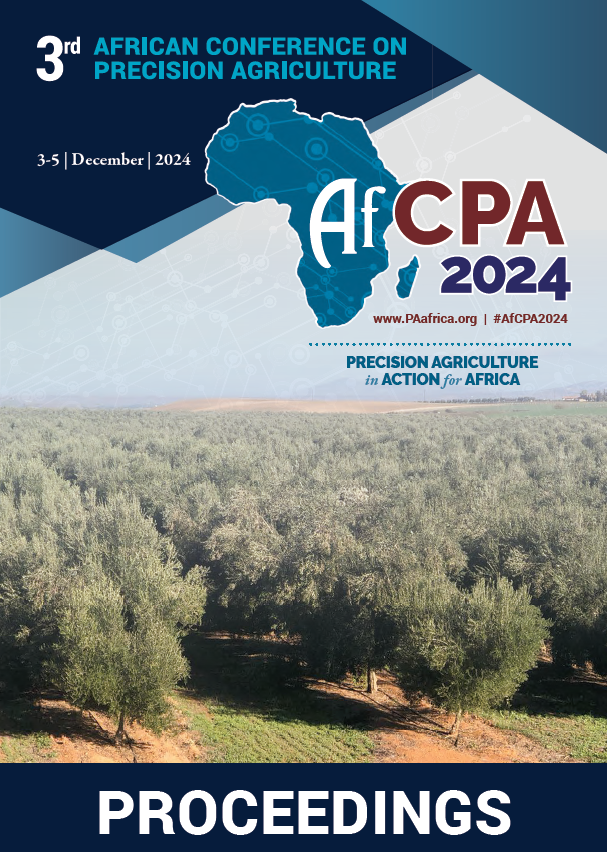Download the Conference Proceedings
Proceedings
Authors
| Filter results7 paper(s) found. |
|---|
1. Development of Canopy Mapping System of Asian pears (Pyrus pyrifolia Naka) Using Terrestrial Laser ScanningIn this paper, the canopy mapping system (CMS) of Asian pears for estimating yield during Bud thinning and Pruning operations using point cloud data was proposed. Bud thinning and Pruning in Asian pear (Pyrus pyrifolia Naka) is necessary to ensure quality and yield but is time-consuming and heavily depends on work knowledge. This study described a method of estimating the number of fruits through the length of a branch based on remote sensing. The CMS would be useful to support more efficient... E. Morimoto, J. Lee, K. Nonami, I. Matumura, M. Ikebe, S. Sato |
2. Application of precision agriculture technologies in grazing: example of goats browsing in forest rangelands of Northern MoroccoThe aim of this study was to characterize patterns of grazing behavior of goats in a Mediterranean forest rangeland. We conducted a one-year study in the Chefchaouen region, Northern Morocco, during two contrasting seasons (spring and summer) using new technological tools. Eight goats were simultaneously fitted with GPS collars and sensors for 3 days during each season. A calibration study and classification tree analysis were used to predict other grazing activities of goats (eating, walking,... Y. Chebli, S. El otmani, M. Chentouf, J. Hornick, J. Cabaraux |
3. Development of Lodging Direction Determination System Using Image ProcessingIn this study, image processing system was developed for application on rice plants to determine lodging condition, which was contributing factor to declining harvester efficiency by using combine harvester. Therefore, We developed a system for determination of the lodging direction by algorithm based on convolutional neural network (CNN). As for deep learning framework, Pytorch1.1.0 were used to train and test the judging direction. GoogLeNet was used as a pre-trained CNN model. Lodging... E. Morimoto, Y. Arai, K. Nonami, T. Ito |
4. Precision Nitrogen Management in Maize Using an Optical Sensor in the Indo-Gangetic PlainsBlanket fertilizer nitrogen (N) for large irrigated maize field lead to low N use efficiency (NUE) due to spatial and in season temporal variability. In order to achieve higher NUE, a fertilizer N management strategy using GreenSeekerTMoptical sensor was evaluated. GreenSeekerTM uses visible and near-infrared spectral response from crop canopies. We conducted 03 field experiments during 2012-14 in monsoon season maize to define relationship and develop algorithm between in season... V. Singh |
5. Mapping African soils at 30m resolution - iSDAsoil - Western Time Zones“iSDAsoil” combines remote sensing data and other geospatial information with carefully stratified point samples subjected to spectral analysis and traditional wet chemistry reference analysis. State of the art machine learning techniques were used to create digital maps of 17 agronomically important soil properties at 3 depths, including estimates of uncertainty. iSDAsoil is designed to encourage sharing and we hope that the owners of other soil and agronomic data, in industry... J. Crouch, K. Shephard, M. Miller, J. Collinson, P. Singh, P. Pypers, R. Van den bosch, C. Van beek, M. Chernet, S. Aston |
6. Mapping African soils at 30m resolution - iSDAsoil - Eastern Time Zones“iSDAsoil” combines remote sensing data and other geospatial information with carefully stratified point samples subjected to spectral analysis and traditional wet chemistry reference analysis. State of the art machine learning techniques were used to create digital maps of 17 agronomically important soil properties at 3 depths, including estimates of uncertainty. iSDAsoil is designed to encourage sharing and we hope that the owners of other soil and agronomic data, in industry... C. Van beek, M. Chernet, S. Aston, M. Miller, J. Collinson, K. Shephard, J. Crouch, T. Terhoeven-urselmans |
7. Using Precision Technologies to Monitor the Grazing Activities of Goat in a North African WoodlandIn the north of Africa, browsing on natural pastures is the main source of feed for domestic goats. Livestock farming, particularly grazing goats, constitutes the prevalent agricultural activity in the mountainous areas of Morocco. Data on animal behavioral activities are essential for understanding their feeding and their interaction with the environment in order to define the optimal management intervention strategies. The recent development of precision farming technologies and the increasing... Y. Chebli, M. Chentouf, J. Cabaraux, S. El otmani |
